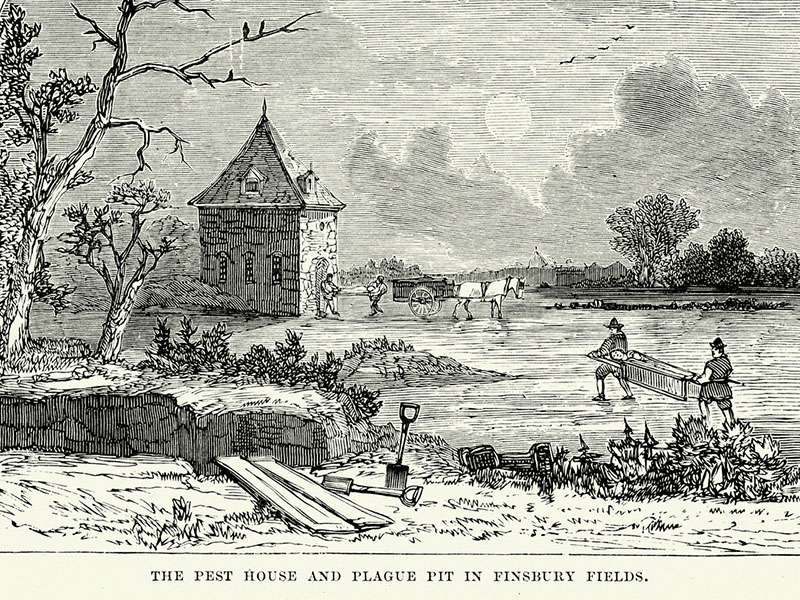
Covid-19 is but a mere a small-time pestilence — so far — compared to the mortality from the Black Death pandemic of 1348-1353 and the bubonic plague epidemic in Europe in the mid-17th century.
The Black Death is estimated to have killed up to 200 million people in Europe, Asia and North Africa, while the bubonic plague of 1665 killed nearly a quarter of London’s population in 18 months. The illnesses spread from person to person due to crowded, unsanitary conditions, and went port to port thanks to shipborne fleas and rats.
The effects of the plague on capital markets in the 14th century were relatively mild: land and machines were not much harmed. Labour, however, suffered greatly, with as many as half of all agricultural workers dying.
Surviving farm workers were more prosperous — suddenly scarce, they demanded and received higher wages. Peasants’ real wages rose between 12% and 28% from the 1340s to the 1350s and then from 20% to 40% from 1350 to 1360.
A study of post-plague conditions in the Middle East also showed higher real wages, which, the authors argue, “contributed to the Golden Age of Islam by creating demand for higher-income goods.”
In general, higher incomes for surviving workers gave them more purchasing power, enabling them to spend more on manufactured goods. That led to more manufactured goods being produced in cities, in turn spurring urbanization.
The Covid-19 pandemic is unlikely to have such a dramatic effect. But it has already led to more warehouses, fewer passenger planes flying, more cargo planes hauling goods from internet-based providers and fewer restaurants serving lunch to now-absent office workers.
History provides a map of where plagues lead populations. Risk of borrower death was correctly seen as an impediment to loan repayment. A key indicator was the return demanded on prestiti: forced loans invented in Venice in the late 13th century. Extracted from the wealthy by the government of Venice, they were repaid by floating nominal interest rates. Those rates rose from about 5% per year in the 1340s, before the plague arrived on ships docking in Venice, to 6% once the plague was in the city.
Return followed risk. But prices of urban goods produced by surviving workers also rose, undercutting the real value of rising wages in the great trading city.
Three centuries later, when the bubonic plague returned to England, rates on loans by goldsmiths to the Crown rose from 8% to as much as 20%. The risk from the lender’s point of view was not just that repayment is made difficult by disease, but that creditors could be outright banished (a tactic used by Philip the Fair of France during his reign from 1285 to 1314). Edward III of England also repudiated loans and ruined his lenders.
Not surprisingly, loans to ordinary businesses bore lower rates than sovereign loans, seeing as businesses could not banish (and generally did not kill) their creditors.
Nonetheless, plagues do not respect banking customs. A study published in April, Long-Run Economic Consequences of Pandemics, showed that real interest rates declined in the wake of plagues. The reason: reduced trade and demand for loanable funds.
Plagues did more than just make labour scarce and reduce demand. Each plague was a cataclysmic event for religion and social cohesion. Extensive infections that killed entire families allowed the established church to gain lands when there was no one left alive to inherit.
The church, heir by stipulation in wills and by default in their absence, was subsequently seen to be too rich by some. Part of the Protestant Reformation focused on excessive land held by the church and cash transfers to it from penitents. Land claims, aided by appeals to piety, led to Henry VIII taking over monasteries and their lands.
Similar processes aided the fragmentation of the church in Germany, Switzerland and other continental countries, thus enriching secular powers. One could even argue that settlers in the New World were fleeing established religion and disease — so it is no small irony that Europeans brought devastating illnesses to the Americas.
Plagues also created vast cultural changes. The Canterbury Tales, the story of a band of pilgrims socially distancing themselves from London and crossing the Thames to martyr Thomas Becket’s shrine, was so popular that the dialect of English in which Geoffrey Chaucer wrote it — the Midlands form — has become the basis for the language we speak today.
We can hope that the present pandemic will not cause the devastation of earlier plagues. But as history has shown, the economic effects of mass infection are powerful and inevitable.